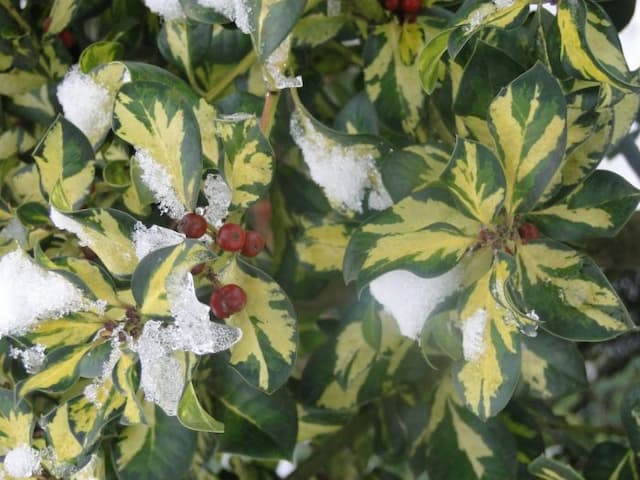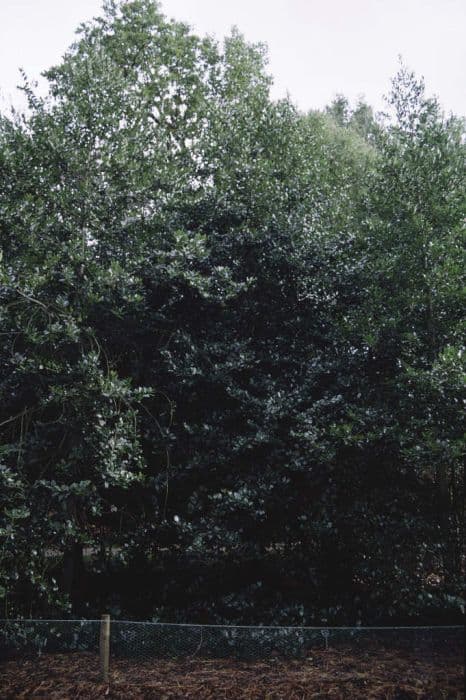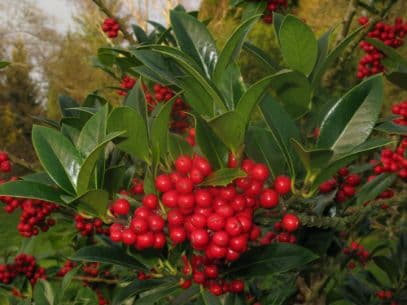Blue Holly Ilex × meserveae Blue Angel = 'Conang' (f)

ABOUT
The Blue Angel Holly is a stunning evergreen shrub known for its beautiful blue-green foliage. This plant has an elegant appearance with glossy, spiny leaves that are deep green in color and possess a distinct blue tint that captures the eye. The foliage not only adds a unique color palette to the garden throughout the year but also provides a dense, lush texture. This holly variety produces relatively large, bright red berries that create a delightful contrast against the blue-green leaves. These berries are especially prominent in the fall and winter, providing a festive touch to the landscape and serving as a source of food for local bird species during the colder months. The Blue Angel Holly also blooms in the spring, featuring small, creamy white flowers. Although these blooms are less showy than the berries and foliage, they add a subtle charm and can attract pollinators to the garden. The overall shape of the Blue Angel Holly is pyramidal, with a natural symmetry that makes it an attractive standalone specimen or a component in hedges and foundation plantings. Its textured leaves and year-round color offer visual interest, making it a versatile and popular choice for gardeners looking to add evergreen structure to their outdoor spaces.
About this plant
 Names
NamesFamily
Aquifoliaceae
Synonyms
Blue Angel Holly, Meserve Holly, Blue Holly
Common names
Ilex × meserveae 'Conang'.
 Toxicity
ToxicityTo humans
Blue Holly is generally considered to have a low level of toxicity to humans. However, if ingested, the berries can cause nausea, vomiting, diarrhea, and abdominal pain. Although it is not often that serious poisoning occurs, it's important to avoid ingesting any part of the plant, especially the berries, as they contain the highest concentration of the toxic substances.
To pets
Blue Holly is also toxic to pets. If your pet consumes any part of the plant, particularly the berries, they may exhibit symptoms such as vomiting, diarrhea, decreased appetite, and depression. It's important to keep an eye on your pet and contact a veterinarian if you suspect they have ingested any part of the plant, as the symptoms could potentially escalate, leading to more severe issues or, in rare cases, be fatal.
 Characteristics
CharacteristicsLife cycle
Perennials
Foliage type
Evergreen
Color of leaves
Dark green
Flower color
White
Height
8 feet (2.44 meters)
Spread
6 feet (1.83 meters)
Plant type
Shrub
Hardiness zones
5
Native area
Cultivar
Benefits
 General Benefits
General Benefits- Ornamental Appeal: The Ilex × meserveae 'Conang' or Blue Angel Holly is prized for its aesthetic attributes, with shiny dark green leaves and bright red berries bringing color to landscapes, especially in winter when other plants may be dormant.
- Wildlife Habitat: The berries provide a valuable food source for birds during the winter months when food is scarce.
- Privacy Screen: Due to its dense growth habit, it can be used as a living privacy screen or hedge that offers year-round coverage.
- Soil Erosion Control: The root system helps bind the soil, reducing erosion, particularly in sloped areas.
- Windbreak: The robust nature of the plant makes it ideal for use as a windbreak, shielding against strong winds and protecting more sensitive plants.
- Versatility: It can adapt to a variety of soil types and is relatively tolerant of urban pollution, making it suitable for different landscapes and environmental conditions.
- Low Maintenance: Once established, it requires minimal care, proving to be a low-maintenance landscape plant that doesn’t demand frequent attention.
- Resistant to Pests and Diseases: It has a good resistance to many common pests and diseases, thereby reducing the need for chemical treatments.
 Medical Properties
Medical PropertiesThis plant is not used for medical purposes.
 Air-purifying Qualities
Air-purifying QualitiesThis plant is not specifically known for air purifying qualities.
 Other Uses
Other Uses- Topiary: Blue Angel Holly can be pruned into various shapes to create decorative topiaries for gardens or landscapes.
- Hedge Plant: This plant is often used as a hedge due to its dense growth habit, providing privacy and wind protection.
- Wildlife Shelter: The thick foliage of the Blue Angel Holly provides shelter to birds and other wildlife during harsh weather conditions.
- Nesting Site: Birds may use the branches of the Blue Angel Holly to build their nests, due to the protection the leaves offer.
- Photography Backdrop: The vivid green leaves and bright berries of the Blue Angel Holly can serve as a beautiful backdrop for outdoor photography.
- Christmas Decorations: Cut branches of the Blue Angel Holly are often used in Christmas wreaths and as part of festive arrangements due to their holiday appearance.
- Erosion Control: Planting Blue Angel Holly on slopes can help prevent soil erosion thanks to its root system.
- Windbreak: In rows or groups, these plants can provide a windbreak to protect more sensitive plants and reduce wind speeds in an area.
- Labyrinth Design: Their tall, dense growth can be used to create living labyrinths or maze gardens for recreational spaces.
- Insect Attraction: The flowers of the Blue Angel Holly attract pollinators like bees, while the berries can attract other insects beneficial for gardens.
Interesting Facts
 Feng Shui
Feng ShuiThe Blue Holly is not used in Feng Shui practice.
 Zodiac Sign Compitability
Zodiac Sign CompitabilityThe Blue Holly is not used in astrology practice.
 Plant Symbolism
Plant Symbolism- Protection: Ilex, commonly known as holly, has long been associated with protection. Traditionally, holly was believed to guard against negative energies and was often planted near houses for this supposed protective benefit.
- Good Fortune: Holly is also often linked with good luck and is commonly used in decorations during the Christmas season to bring prosperity and joy to the household.
- Endurance and Strength: Holly is an evergreen plant, which symbolizes its ability to endure through harsh conditions, representing hope and personal strength.
- Festivity and Celebration: As a plant that is well-regarded for its role in Christmas decorations, holly symbolizes festivity and celebration, marking joyous occasions.
- Renewal: The ability of holly to stay green throughout the year is also interpreted as a sign of renewal and the continuous cycle of life and nature.
 Water
WaterBlue Holly 'Blue Angel' should be watered thoroughly when the top inch of soil feels dry to the touch, typically every one to two weeks depending on weather conditions. During the hotter, dry months, water needs may increase, requiring more frequent watering. Provide about 1-2 gallons of water per plant for each watering session. It's crucial not to overwater the Blue Holly, as it doesn't like to sit in waterlogged soil. Ensure that the plant has good drainage to prevent root rot. During winter, reduce watering as the plant's growth slows down and it requires less moisture.
 Light
LightBlue Holly 'Blue Angel' thrives best in full sun to partial shade. Ideally, it should receive at least 4-6 hours of direct sunlight per day. If planted in too much shade, the plant may not produce as many berries, and its growth could be stunted. The best spot for planting Blue Holly is in an area where it receives morning sunlight and some afternoon shade, particularly in hotter climates.
 Temperature
TemperatureBlue Holly 'Blue Angel' is hardy and can tolerate a range of temperatures. It prefers a temperature range of about 35-80 degrees Fahrenheit and can withstand minimum winter temperatures down to around -10 degrees Fahrenheit. Ideal growth occurs in climates where temperatures remain within the preferred range, but it is quite adaptable to temperature fluctuations.
 Pruning
PruningBlue Holly 'Blue Angel' should be pruned to maintain its shape and promote vigorous growth, typically in late winter or early spring before new growth starts. Pruning can also be done after the plant has produced berries, as this allows for the enjoyment of the winter berries before cutting. Prune selectively to remove any dead or damaged branches and to shape the plant as desired. Pruning every year or every few years helps to rejuvenate the plant and encourages denser foliage.
 Cleaning
CleaningAs needed
 Soil
SoilBlue Holly 'Blue Angel' thrives in a well-draining, acidic soil mix with a pH of 5.0-5.5. A blend of peat moss, compost, and a small amount of sand or perlite will provide the ideal structure and fertility.
 Repotting
RepottingBlue Holly 'Blue Angel' should be repotted every 3 to 5 years. The spring season is the best time for repotting this plant.
 Humidity & Misting
Humidity & MistingBlue Holly 'Blue Angel' prefers moderate humidity levels, ideally between 40% to 60%. The plant is tolerant of lower humidity but thrives in these conditions.
 Suitable locations
Suitable locationsIndoor
Place Blue Holly 'Blue Angel' in bright indirect light indoors.
Outdoor
For Blue Holly 'Blue Angel', plant in partial sun to shade.
Hardiness zone
5-9 USDA
 Life cycle
Life cycleBlue Angel Holly ('Conang') begins its life as a seed, which, after a period of dormancy, germinates and sprouts in the spring, growing into a small seedling. As the seedling develops, it forms a root system and foliage, entering a stage of rapid vegetative growth where it matures into a shrub with glossy, spiny, dark blue-green leaves and a rounded growth habit. Once mature, usually after a few years, it enters the reproductive phase, producing small white flowers that are typically pollinated by bees; as a female cultivar, it requires the presence of a male holly for pollination to occur. Successful pollination results in the development of bright red berries, which persist through the winter and serve as a food source for birds while providing ornamental interest. Over many years, the shrub can become quite large, up to 10-15 feet in height, forming a dense, pyramidal to conical shape. Eventually, as the plant ages and reaches the end of its lifespan, it may experience a decline in vigor, producing fewer flowers and berries, until it dies back and decomposes, thereby returning nutrients to the soil and completing its life cycle.
 Propogation
PropogationPropogation time
Early Spring
Ilex × meserveae 'Conang', commonly known as Blue Angel Holly, is typically propagated by semi-hardwood cuttings. The best time to take these cuttings is in late summer to early fall, when the current year's growth has started to mature and harden slightly. To propagate by cuttings, a 4 to 6-inch length of stem is cut just below a leaf node, and the lower leaves are removed. The cut end is then dipped into rooting hormone to encourage root development and planted in a mixture of peat and perlite or a similar rooting medium. The cuttings should be kept in a well-lit area out of direct sunlight and maintained at a consistent moisture level. Rooting can take several weeks to months, but once new growth appears, it indicates that the cutting has successfully rooted and can be gradually acclimated to outdoor conditions before transplanting.









